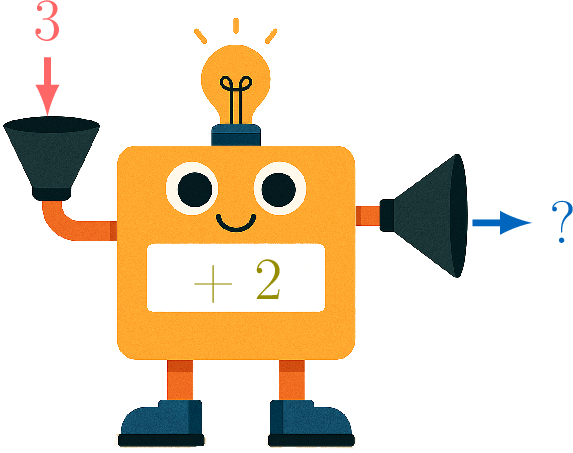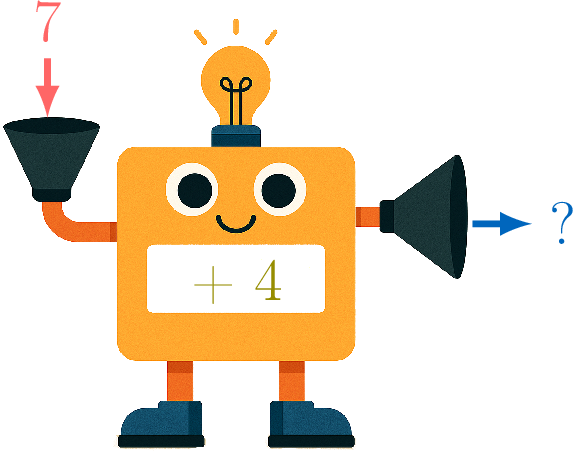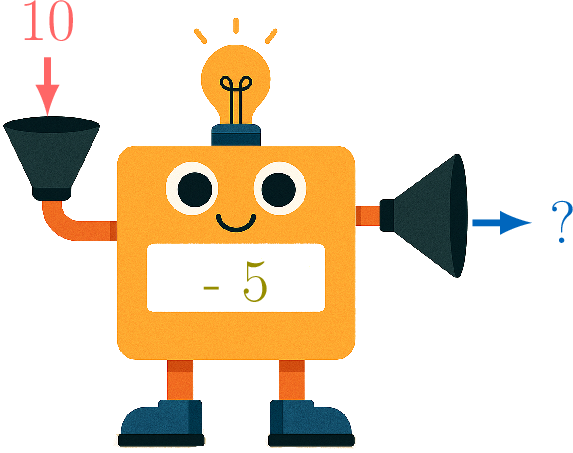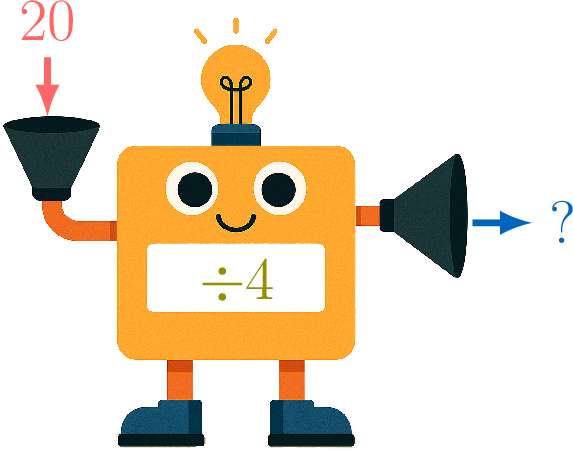Functions
What is a Function?
Calculating the Output of a Function
Exercise

- Rule: \(\textcolor{olive}{\text{add 2}}\)
- Input: \(\textcolor{colordef}{3}\)
- Output:
The output is \(\textcolor{colordef}{3}\textcolor{olive}{+2} =\textcolor{colorprop}{5}\).
Exercise

- Rule: \(\textcolor{olive}{\text{subtract 3}}\)
- Input: \(\textcolor{colordef}{5}\)
- Output:
The output is \(\textcolor{colordef}{5}\textcolor{olive}{-3} =\textcolor{colorprop}{2}\).
Exercise

- Rule: \(\textcolor{olive}{\text{multiply by 2}}\)
- Input: \(\textcolor{colordef}{3}\)
- Output:
The output is \(\textcolor{colordef}{3}\textcolor{olive}{\times 2} =\textcolor{colorprop}{6}\).
Exercise

- Rule: \(\textcolor{olive}{\text{divide by 2}}\)
- Input: \(\textcolor{colordef}{8}\)
- Output:
The output is \(\textcolor{colordef}{8}\textcolor{olive}{\div 2} =\textcolor{colorprop}{4}\).
Exercise

- Rule: \(\textcolor{olive}{\text{add 4}}\)
- Input: \(\textcolor{colordef}{7}\)
- Output:
The output is \(\textcolor{colordef}{7}\textcolor{olive}{+4} =\textcolor{colorprop}{11}\).
Exercise

- Rule: \(\textcolor{olive}{\text{subtract 5}}\)
- Input: \(\textcolor{colordef}{10}\)
- Output:
The output is \(\textcolor{colordef}{10}\textcolor{olive}{-5} =\textcolor{colorprop}{5}\).
Exercise

- Rule: \(\textcolor{olive}{\text{multiply by 4}}\)
- Input: \(\textcolor{colordef}{6}\)
- Output:
The output is \(\textcolor{colordef}{6}\textcolor{olive}{\times 4} =\textcolor{colorprop}{24}\).
Exercise

- Rule: \(\textcolor{olive}{\text{divide by 4}}\)
- Input: \(\textcolor{colordef}{20}\)
- Output:
The output is \(\textcolor{colordef}{20}\textcolor{olive}{\div 4} =\textcolor{colorprop}{5}\).
Table of Values
Finding the Rule of a Function
Exercise
For these inputs and outputs, find the rule:



\(\textcolor{olive}{\text{Rule}}\):
| Input | 2 | 4 | 6 |
| Output | 5 | 7 | 9 |



- \(\textcolor{colordef}{2}\textcolor{olive}{+\,3} = \textcolor{colorprop}{5}\)
- \(\textcolor{colordef}{4}\textcolor{olive}{+\,3} = \textcolor{colorprop}{7}\)
- \(\textcolor{colordef}{6}\textcolor{olive}{+\,3} = \textcolor{colorprop}{9}\)
Exercise
For these inputs and outputs, find the rule:



\(\textcolor{olive}{\text{Rule}}\):
| Input | 5 | 8 | 11 |
| Output | 3 | 6 | 9 |



- \(\textcolor{colordef}{5}\textcolor{olive}{-\,2} = \textcolor{colorprop}{3}\)
- \(\textcolor{colordef}{8}\textcolor{olive}{-\,2} = \textcolor{colorprop}{6}\)
- \(\textcolor{colordef}{11}\textcolor{olive}{-\,2} = \textcolor{colorprop}{9}\)
Exercise
For these inputs and outputs, find the rule:



\(\textcolor{olive}{\text{Rule}}\):
| Input | 1 | 2 | 3 |
| Output | 2 | 4 | 6 |



- \(\textcolor{colordef}{1}\textcolor{olive}{\times\,2} = \textcolor{colorprop}{2}\)
- \(\textcolor{colordef}{2}\textcolor{olive}{\times\,2} = \textcolor{colorprop}{4}\)
- \(\textcolor{colordef}{3}\textcolor{olive}{\times\,2} = \textcolor{colorprop}{6}\)
Exercise
For these inputs and outputs, find the rule:



\(\textcolor{olive}{\text{Rule}}\):
| Input | 2 | 6 | 10 |
| Output | 1 | 3 | 5 |



- \(\textcolor{colordef}{2}\textcolor{olive}{\div\,2} = \textcolor{colorprop}{1}\)
- \(\textcolor{colordef}{6}\textcolor{olive}{\div\,2} = \textcolor{colorprop}{3}\)
- \(\textcolor{colordef}{10}\textcolor{olive}{\div\,2} = \textcolor{colorprop}{5}\)
Calculating the Outputs of a Function
Exercise
For the rule "add 2",  , complete the table of values:
, complete the table of values:
 , complete the table of values:
, complete the table of values:| Input | 2 | 3 | 4 |
| Output |
- \(\textcolor{colordef}{2}\textcolor{olive}{+ 2} = \textcolor{colorprop}{4}\)
- \(\textcolor{colordef}{3}\textcolor{olive}{+ 2} = \textcolor{colorprop}{5}\)
- \(\textcolor{colordef}{4}\textcolor{olive}{+ 2} = \textcolor{colorprop}{6}\)
Exercise
For the rule "add 3",  , complete the table of values:
, complete the table of values:
 , complete the table of values:
, complete the table of values:| Input | 0 | 5 | 10 |
| Output |
- \(\textcolor{colordef}{0}\textcolor{olive}{+ 3} = \textcolor{colorprop}{3}\)
- \(\textcolor{colordef}{5}\textcolor{olive}{+ 3} = \textcolor{colorprop}{8}\)
- \(\textcolor{colordef}{10}\textcolor{olive}{+ 3} = \textcolor{colorprop}{13}\)
Exercise
For the rule "subtract 5",  , complete the table of values:
, complete the table of values:
 , complete the table of values:
, complete the table of values:| Input | 6 | 12 | 20 |
| Output |
- \(\textcolor{colordef}{6}\textcolor{olive}{- 5} = \textcolor{colorprop}{1}\)
- \(\textcolor{colordef}{12}\textcolor{olive}{- 5} = \textcolor{colorprop}{7}\)
- \(\textcolor{colordef}{20}\textcolor{olive}{- 5} = \textcolor{colorprop}{15}\)
Exercise
For the rule "multiply by 10",  , complete the table of values:
, complete the table of values:
 , complete the table of values:
, complete the table of values:| Input | 2 | 5 | 20 |
| Output |
- \(\textcolor{colordef}{2}\textcolor{olive}{\times 10} = \textcolor{colorprop}{20}\)
- \(\textcolor{colordef}{5}\textcolor{olive}{\times 10} = \textcolor{colorprop}{50}\)
- \(\textcolor{colordef}{20}\textcolor{olive}{\times 10} = \textcolor{colorprop}{200}\)
Exercise
For the rule "divide by 5",  , complete the table of values:
, complete the table of values:
 , complete the table of values:
, complete the table of values:| Input | 5 | 10 | 20 |
| Output |
- \(\textcolor{colordef}{5}\textcolor{olive}{\div 5} = \textcolor{colorprop}{1}\)
- \(\textcolor{colordef}{10}\textcolor{olive}{\div 5} = \textcolor{colorprop}{2}\)
- \(\textcolor{colordef}{20}\textcolor{olive}{\div 5} = \textcolor{colorprop}{4}\)